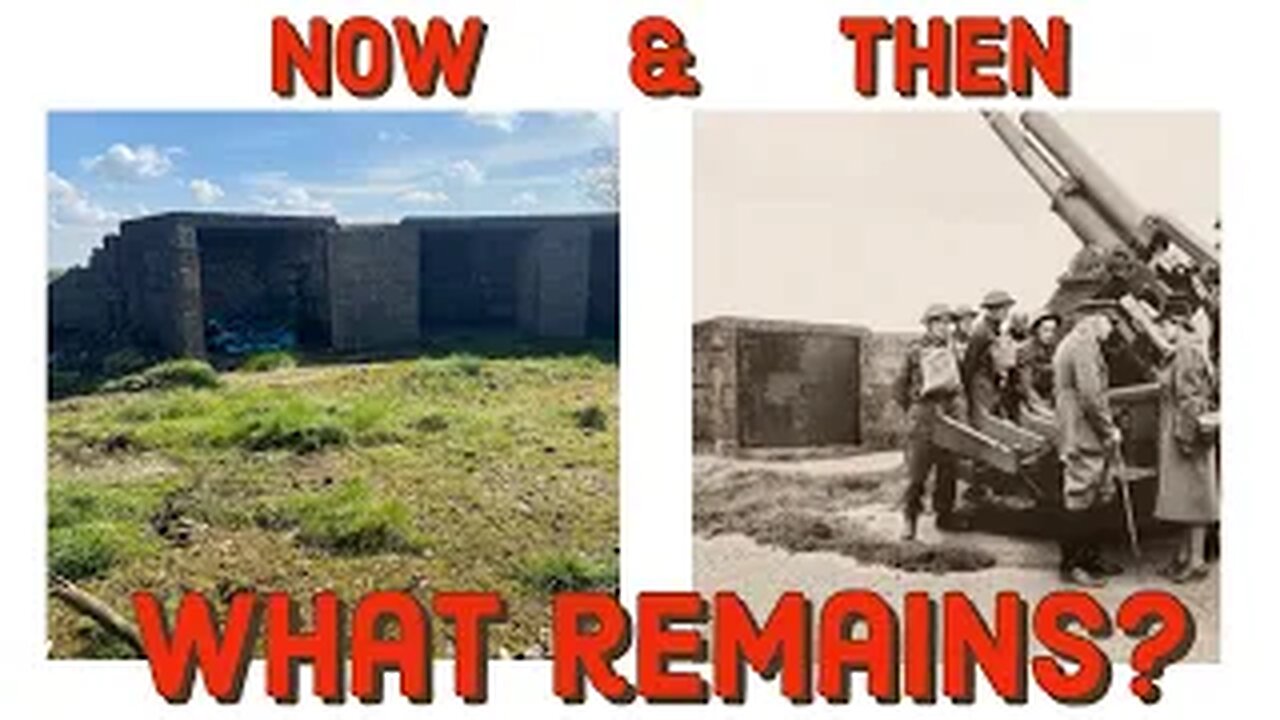Premium Only Content

Anti-aircraft gunsite 280m east of Carlton Hall. A Scheduled Monument in Carlton, Leeds
The monument includes the standing, buried and earthwork remains of a World
War II Heavy Anti-aircraft (HAA) gunsite known as Station includes seven gun emplacements, including one for a Light Anti-aircraft (LAA)
weapon, four gun pits and a command post.
It is unclear exactly when Station H21 was established but it is known to have
been unarmed in June 1942 when the site was mentioned in an Anti-aircraft
Command letter. Guns were often moved from one site to another during the war
and the fact that a site was unarmed at any particular time does not
necessarily mean it had been totally abandoned. The site was probably
connected with the defence of Leeds generally and Yeadon airfield in
particular, the latter of which lies just under 2km to the south.
The Anti-aircraft (AA) guns were used not only for destroying enemy aircraft
but, more importantly, to keep all enemy aircraft at a high altitude and to
deter them from flying on the straight and even course necessary for accurate
bombing. Another important function of AA guns was to indicate the position of
enemy aircraft to their own fighters. Often, when an enemy plane was out of range, the guns would fire one or two rounds to burst as near as possible,
simply to draw the fighters attention to the enemy. The HAA gun emplacements,
four gun pits and command post are all constructed out of concrete and breeze
blocks and broadly follow standard designs. The four gun pits are arranged ina semi-circle around the north west side of the command post, with two
unenclosed gun emplacements lying outside the semi-circular arrangement to the
north west and south east. The gun pits incorporate characteristics of both
the March 1938 pattern which were octagonal in plan and had twin axial
entrances, and the DFW 55414 design, which was issued by the Directorate of
Fortifications and Works (DFW) on 10th October 1942 and had a single entrance
and external ammunition recesses and shelters. Both types were designed for
3.7inch guns, although some of the earlier examples were designed for 4.5inch
guns.
The gun emplacements are basically octagonal concrete pads set level with the
ground surface, with a standard ring of holding down bolts for fixing the gun mounting. The gun pits surrounding four of the gun emplacements are octagonal,
approximately 8m in diameter with 2m high concrete and breeze block walls.
Each gun pit has twin axial entrances which align directly with the command
post. The surrounding walls form three, roofed, compartments on each side of
which the central one leads to a shelter at the rear. On one side the shelter
was typically used as a relaxed duty shelter for the gun crew, the other for
gun maintenance. The other recesses were used for stacking ammunition and
fuses of different, preset lengths.
The LAA gun emplacement, which lies approximately 1m north of the command
post, is brick built and circular in plan, with a wooden beam standing
vertically at its centre and an entrance to the north. The structure is about
2m in diameter with walls that stand 1.5m in height. This is a gun emplacement
for a Light Anti-aircraft (LAA) weapon such as the Lewis gun. Such weapons
were intended for local defence of closely defined targets, principally
against aircraft operating at a height of less than 3000 feet.
The command post is E shaped in plan, semi-sunken and is constructed of breeze
block and concrete with some metal fittings and pipe work surviving. The
bases of various instrument mountings survive in an area at the front of the
building which is enclosed although open to the sky. In operation these
mountings would have housed an identification telescope, the predictor (a
mechanical computer), and height finder. These fed information to the
plotting room, a long room in the covered part of the command post where the
bearing, elevation and range were calculated and relayed to the guns. Other
rooms in the command post acted as offices, stores and communication rooms.
The building faces to the north west so that the Gun Position Officer (GPO),
who was in charge of the command post, could control the firing of the guns,
watch the effects of the fire and take responsibility for the identification
of enemy aeroplanes.
CONTACT. email: NMCGpost@gmail.com
-
 3:47:54
3:47:54
I_Came_With_Fire_Podcast
16 hours agoDEPARTMENT OF EDUCATION AXED | GAZA ULTIMATUM
74.1K18 -
 2:16:53
2:16:53
FreshandFit
13 hours agoCall-In Show
92.6K12 -
 4:27:46
4:27:46
Nerdrotic
17 hours ago $61.06 earnedDaredevil Born Again REVIEW, Harry Potter Show DOA, DC HACKED! | Friday Night Tights 344 Paul Chato
184K55 -
 1:15:15
1:15:15
Glenn Greenwald
14 hours agoWeek in Review: Lee Fang and Leighton Woodhouse on Ukraine War and NYT Piece Revealing Tensions within Trump Admin; PLUS: Lee Fang Takes Audience Questions on DOGE and Big Tech | SYSTEM UPDATE #420
116K56 -
 1:03:30
1:03:30
Sarah Westall
16 hours agoMassive Government Overhaul: FBI, CIA, IRS and more to be Gutted w/ Sam Anthony
114K31 -
 1:07:40
1:07:40
IsaacButterfield
16 hours ago $5.83 earnedAustralia Under Attack | Trump's State of the Union | All LGBTQ Cast (W Guest Frenchy)
60.9K15 -
 1:23:37
1:23:37
Edge of Wonder
16 hours agoIs Your Car Collecting Your Biodata? Whistleblower Exposes Dark Agenda
57.8K13 -
 2:08:50
2:08:50
Quite Frankly
19 hours ago"A Rat at HHS, Gene Hackman, Musical Extras" ft. J Gulinello 3/7/25
56.9K15 -
 55:49
55:49
LFA TV
1 day agoGermany Started Two World Wars and Now Wants Nuclear Weapons | TRUMPET DAILY 3.7.25 7PM
47.7K50 -
 1:34:38
1:34:38
2 MIKES LIVE
15 hours ago2 MIKES LIVE #189 Open Mike Friday (Sort Of)
34.2K